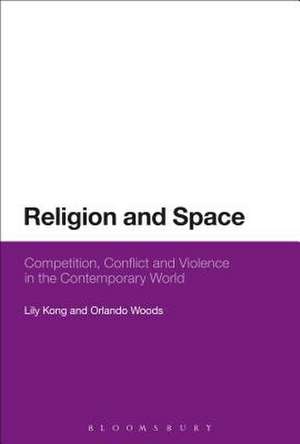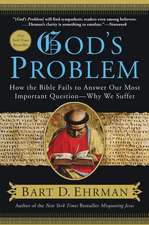Religion and Space: Competition, Conflict and Violence in the Contemporary World
Autor Dr Lily Kong, Orlando Woodsen Limba Engleză Hardback – 10 feb 2016
| Toate formatele și edițiile | Preț | Express |
|---|---|---|
| Paperback (1) | 256.20 lei 6-8 săpt. | |
| Bloomsbury Publishing – 23 aug 2017 | 256.20 lei 6-8 săpt. | |
| Hardback (1) | 772.98 lei 6-8 săpt. | |
| Bloomsbury Publishing – 10 feb 2016 | 772.98 lei 6-8 săpt. |
Preț: 772.98 lei
Preț vechi: 989.98 lei
-22% Nou
Puncte Express: 1159
Preț estimativ în valută:
147.93€ • 154.24$ • 122.94£
147.93€ • 154.24$ • 122.94£
Carte tipărită la comandă
Livrare economică 21 martie-04 aprilie
Preluare comenzi: 021 569.72.76
Specificații
ISBN-13: 9781474257404
ISBN-10: 1474257402
Pagini: 216
Dimensiuni: 156 x 234 x 20 mm
Greutate: 0.48 kg
Editura: Bloomsbury Publishing
Colecția Bloomsbury Academic
Locul publicării:London, United Kingdom
ISBN-10: 1474257402
Pagini: 216
Dimensiuni: 156 x 234 x 20 mm
Greutate: 0.48 kg
Editura: Bloomsbury Publishing
Colecția Bloomsbury Academic
Locul publicării:London, United Kingdom
Caracteristici
Uses extensive global case studies, including India, the USA, the UK, Pakistan and Thailand
Notă biografică
Lily Kong is Lee Kong Chian Professor of Social Sciences and Provost at the Singapore Management University, Singapore.Orlando Woods is a Researcher at Asian Strategies, Singapore.
Cuprins
1. Religious Competition and Space2. Religious Space: Competition, Conflict and Violence3. Religion in Secular Spaces4. Globalisation and Religious Competition and Conflict5. Social Resilience and Religion6. Conclusions: (Re)conceptualising Religion and Space in a Globalised WorldBibliographyIndex
Recenzii
This is a timely book on an important topic. It surveys the whole field and provides case studies from recent conflicts -- a useful reference for academics, policy-makers and anyone concerned about how religious interests can rise above the competition over common turf.
All those interested in religion and geography will find much to engage them here, but this interdisciplinary book will be especially welcome for those who want to understand how spaces can prompt religious conflict and how we might create a more peaceful world.
Timely, authoritative and compelling, Religion and Space encapsulates state of the art thinking within geographies of religion. While religions world-wide are often seen in light of conflict resolution and peace-building, the book centrally conceptualizes religions from the premise of competition, conflict and violence within pluralist societies under conditions of globalization. Drawing on several insightful sources, namely the Romanian religious historian Mircea Eliade and French Marxist philosopher Henri Lefebvre, the authors show how religious and secular claims to space have been and continue to be negotiated in the post-war period of modernity. The first study to confront sacred space with religious violence, we are provided with an important reminder of how a spatial perspective on religion explains the persistence of violence as well as a vehicle for social resilience and regulation.
All those interested in religion and geography will find much to engage them here, but this interdisciplinary book will be especially welcome for those who want to understand how spaces can prompt religious conflict and how we might create a more peaceful world.
Timely, authoritative and compelling, Religion and Space encapsulates state of the art thinking within geographies of religion. While religions world-wide are often seen in light of conflict resolution and peace-building, the book centrally conceptualizes religions from the premise of competition, conflict and violence within pluralist societies under conditions of globalization. Drawing on several insightful sources, namely the Romanian religious historian Mircea Eliade and French Marxist philosopher Henri Lefebvre, the authors show how religious and secular claims to space have been and continue to be negotiated in the post-war period of modernity. The first study to confront sacred space with religious violence, we are provided with an important reminder of how a spatial perspective on religion explains the persistence of violence as well as a vehicle for social resilience and regulation.









